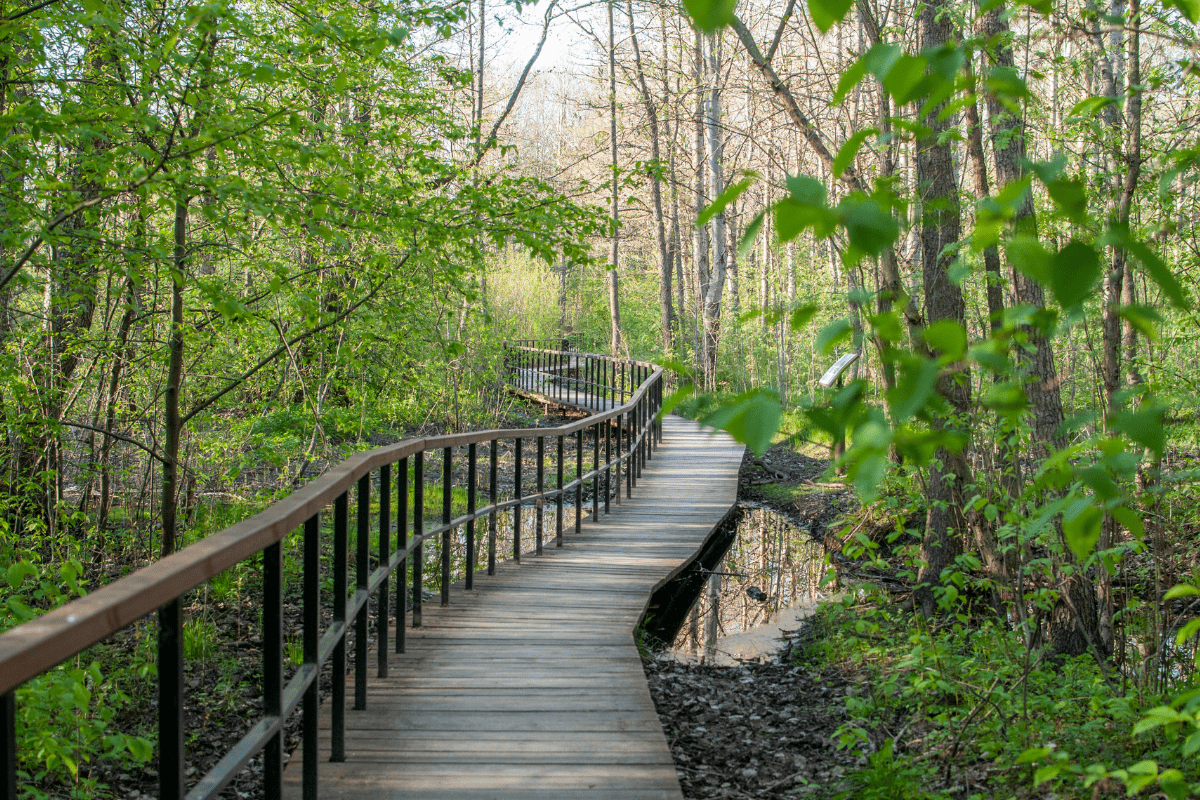Jupiter overflows with hiking trails that reveal wild rivers, shady forests, and tranquil beaches. Whether you crave a quick stroll by the water or a long trek through pine flatwoods, you’ll find a spot to match your mood and energy.
Let’s get to it.
Riverbend Park
At Riverbend Park, trails span over nine miles across flat shell-rock surfaces. The 2.6-mile loop offers a quick option, and you can extend the route on out-and-back paths toward Loxahatchee Slough or Masten Dam. Wooden boardwalks with railings appear along wetter sections, making the park accessible for all ages.
Signage throughout the preserve prevents hikers from losing their way. Wildlife sightings are common: white-tailed deer graze in the underbrush and various waterfowl nest near marshy edges. Occasionally an alligator basks by the water’s edge, adding an authentic touch of Florida. Benches dot the trail and provide resting spots every half mile.
Parking here is plentiful and restrooms are modern. Dozens of picnic tables sit beneath live oaks and cabbage palms. Dogs on leashes are welcome on most trails, though a few areas restrict pets to protect sensitive habitats. The maintenance team keeps paths clear and boardwalks in good repair. On busy weekends the park remains peaceful enough to hear insects or the call of a woodpecker.
Jupiter Ridge Natural Area
At Jupiter Ridge Natural Area, you experience classic Florida landscapes paired with accessible trails. The Little Blue Heron boardwalk is ADA-friendly, and beyond that you’ll find the Pawpaw Trail and Scrub Lizard Trail with soft sand that keeps these easy routes feeling characteristically Floridian. Weekdays are quiet, so you can often watch gopher tortoises from a distance without weaving through crowds.
Gentle dunes and mangroves border several waterway overlooks, especially at Ski Beach. Wildlife sightings include manatees near the shore, a variety of water birds, and the quick movements of scrub lizards. Facilities are basic but helpful: a small parking area, restrooms, benches, and an educational kiosk designed to highlight local flora and fauna. Dogs are not permitted, and some sandy side trails lack clear signage—consider using GPS if you explore off the main loops. Open from sunrise to sunset, Jupiter Ridge is ideal outside of summer heat when shade is limited and humidity peaks.
Loxahatchee River Battlefield Park
Loxahatchee River Battlefield Park combines natural beauty with local history across nearly ten miles of trails. The primary 2.6-mile loop includes a boardwalk that spans wetlands and offers river views. Beyond that, hard-packed shell-rock paths branch into wooded areas and riverbank sections.
Many trails remain flat and stroller-friendly, though some dirt spurs grow muddy after rain. Wildlife appears along the routes: deer emerge at dawn and songbirds flit between palm fronds. Historic markers note skirmish sites from early American conflicts, with interpretive signs providing context.
Picnic sites include open-air pavilions and shaded chickee huts close to parking areas. Restrooms are easy to find and parking accommodates cars, trailers and even equestrian rigs. Boat ramps and canoe launches on the river invite paddlers to explore current channels.
Weekend traffic increases during the cooler months but never overwhelms the park’s ample space. Maintenance crews sweep trails and clear brush regularly. Visitors appreciate the combination of active recreation, quiet river scenery and a glimpse into Florida’s past.
Ocean Cay Park
Ocean Cay Park features a half-mile beachfront boardwalk that leads from the parking area to the shoreline. Wide paved paths with gentle slopes connect accessible parking spaces to beach entrances. Handrails on elevated sections help visitors in wheelchairs or with strollers navigate the dunes safely.
Lifeguards patrol the sand during daylight hours and showers near the restrooms rinse off salt and sand. A playground cluster lies just inland from the beach, with swings, slides and shaded benches. Picnic tables nestle beneath sea grape trees, providing lunch spots close to the surf.
Free parking accommodates cars and vans and includes several accessible bays. Dogs on leashes join owners along paved trails but must stay off the sand. The county keeps restrooms clean and replaces damaged boardwalk planks promptly.
On winter weekends, the park draws snowbirds seeking mild temperatures and clear ocean views. Yet the shoreline never feels overcrowded. Between sunrise and mid-morning, visitors can spot pelicans diving offshore and crabs scuttling across the damp sand.
Busch Wildlife Sanctuary
The Busch Wildlife Sanctuary provides a compact but varied experience across about 20 acres. Smooth paved trails and wooden boardwalks wind through pine flatwoods into shaded cypress wetlands. Railings guard all elevated sections, making access easier for wheelchairs and strollers.
Enclosed habitats feature otters splashing in shallow pools and a bear resting on a rocky ledge. Informational signs near each exhibit explain species behavior and conservation efforts. Elsewhere, benches appear at regular intervals, offering relief under oak canopy or next to open meadows.
A small Welcome Center includes restrooms and water fountains. Shaded picnic tables nearby allow visitors to enjoy packed lunches. Service animals are welcome, though pets remain restricted. On weekday mornings the sanctuary feels calm and nearly empty, while weekends attract more families eager for outdoor learning.
Staff members maintain the grounds meticulously, clearing fallen branches and repainting exhibit fencing. Interpretive trails emphasize native plants, so birdwatchers often spot woodpeckers or herons stalking insects in shallow water.
DuBois Park
Strolling along DuBois Park, visitors follow a paved loop of nearly one mile beside water views of the Jupiter Inlet, Atlantic Ocean and Intracoastal Waterway. The trail remains completely flat and the boardwalk stretches safely over marshy ground with sturdy railings.
Benches line the path under mature live oaks. Picnic pavilions and grills offer shaded spots for families to eat. A playground stands off the main trail, letting children run free while adults relax nearby. Kayak and paddleboard launch areas are available at the inlet access point and the swimming area provides a lifeguard on duty during peak hours.
Parking at the park is free and bathrooms stay clean. The grounds receive regular maintenance so pathways stay clear of debris. Dogs on leashes may join walkers on paved sections but must avoid sandy beach zones. Weekend mornings bring more visitors, making weekday afternoons a quieter option. Historical artifacts such as a galleon anchor and antique cannons add local interest along the shoreline.
Jonathan Dickinson State Park River Campground
Jonathan Dickinson State Park’s River Campground offers 52 sites equipped with water and electric hookups. Restrooms feature tiled floors and hot showers, and a laundry facility handles longer stays. Each campsite includes a picnic table and grill, covering the camping essentials.
Several trails start from the campground. The River Trail is a 0.75-mile route beside the Loxahatchee River, complete with overlooks and mangrove stands. Kitching Creek Nature Trail loops 1.5 miles over a mix of boardwalk and dirt, with benches positioned for birdwatching stops. For more shade, the Wilson Creek loop winds half a mile through dense forest canopy. Longer options include segments of the Florida Trail and the rugged Camp Murphy paths, which feature tangled roots and sandy stretches. Cyclists, hikers, and leashed dogs can share many of the routes, though narrow sections require attention. While summer heat and mosquitoes are factors, this riverside campground remains a reliable spot for a range of outdoor activities.
Cinquez Park
In Cinquez Park, 13 acres accommodate a smooth, 0.7-mile flat walking loop that remains accessible to strollers and wheelchairs. This wide pathway circles a pond where birds gather, and benches throughout invite you to pause. Two fenced dog runs give pups room to roam safely—one side for larger breeds and the other for smaller ones.
Beyond the path, you’ll find shaded pavilions, real restrooms, and bike racks. The park’s simple layout keeps visitor numbers low, so despite the convenient rest areas you rarely feel crowded. A modest elevation gain of six feet provides just enough variation without turning a stroll into a climb. Cinquez Park delivers practical features in a compact footprint, making it a solid choice for daily walks or a brief outing with pets and family.
Carlin Park
Spanning 109 acres along the Atlantic coast, Carlin Park offers something for everyone. Its main 1.5-mile loop weaves over wood chips, dirt, pavement, and a few boardwalk sections. A shorter West Loop brings you closer to the beach. Elevation changes top out around 13 feet on a single circuit or closer to 56 feet if you combine both loops. Ocean glimpses appear throughout, and you might even spot a gopher tortoise peeking through the scrub.
Amenities feel generous for a county park. Free parking and restrooms with outdoor showers are steps from shaded benches. Active visitors can tackle a 20-station exercise course or reserve picnic shelters and grills. Two playgrounds and courts for tennis, pickleball, and volleyball keep everyone busy. Well-behaved dogs on a six-foot leash are welcome, and crowds remain moderate thanks to the park’s spread-out layout. Families, runners, casual sunbathers, and regulars mingle without stepping on each other’s toes.
Pine Glades Natural Area
Pine Glades Natural Area offers between 7.3 and 9.1 miles of trails across mostly flat terrain. Sandy walkways and boardwalk sections connect to a paved loop that accommodates wheelchairs and strollers. A few wet patches can make certain paths slippery, so wear suitable footwear.
Birdwatchers and trail runners frequent the area for sightings of roseate spoonbills, egrets, and orchids. A fishing pier and canoe/kayak launch invite water-based exploration, while a covered picnic shelter provides a break spot. Entrance is free, and a well-maintained parking lot sits near portable restrooms. Dogs are not allowed, preserving the quiet habitat for local wildlife. Winter visits tend to be more comfortable, as summer conditions bring high humidity and standing water on some trails. Pine Glades remains a straightforward destination for anyone seeking a variety of gentle outdoor experiences.
Cypress Creek Natural Area
Tucked away in northeastern Florida, Cypress Creek Natural Area offers a network of level trails that are easy on the lungs. Don’t expect steep climbs here. The biggest elevation change is stepping over a tree root. The Osprey and Jesup loops remain flat and beginner-friendly. Wild Cat trail adds a touch of challenge, while Winterhawk provides four miles of paved pathway for strollers and casual walkers.
Underfoot you’ll find dirt, crushed shell, raised berms winding through pine woods, and lengthy boardwalks stretching into the cypress swamp. Scattered benches and shade shelters give you a place to pause. Birdwatchers gather in spring to spot ospreys and sandhill cranes without fighting crowds. Horse riders share the route too, so keep an eye out for equine traffic. There are no pets or restrooms, so carry water and plan pit stops before you start. Trails stay relatively dry from November through April if it doesn’t pour, yet they can turn slippery after heavy rain. Admission is free, signage is clear, and spring brings colorful wildflowers. This county-managed gem remains tidy and welcoming year-round.
Delaware Scrub Natural Area
At just 16 acres in Jupiter, Florida, Delaware Scrub Natural Area packs diverse habitats into a compact space. Signage keeps you on track and steers clear of poison ivy. Five parking spots mean you won’t wait to park. A paved trail welcomes strollers and wheelchairs, then a sandy footpath leads to a wooden boardwalk skimming across a cypress dome swamp. An observation platform overlooks Jones Creek. Beyond the water’s edge you’ll pass pine flatwoods, tidal mangroves, and scrub.
In spring, wildflowers burst into color. You won’t see cyclists racing past narrow paths. Bikes must stay in the rack and dogs are not allowed. A kayak tie-up on the creek invites paddlers to arrive by water. Benches and an educational kiosk offer rest stops and quick facts about the local ecosystem. During cooler months manatees may drift by offshore. Despite occasional road noise, this tidy preserve remains one of the most accessible and well-maintained spots in the county.





